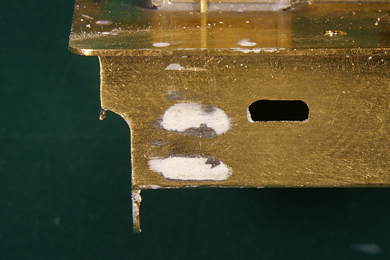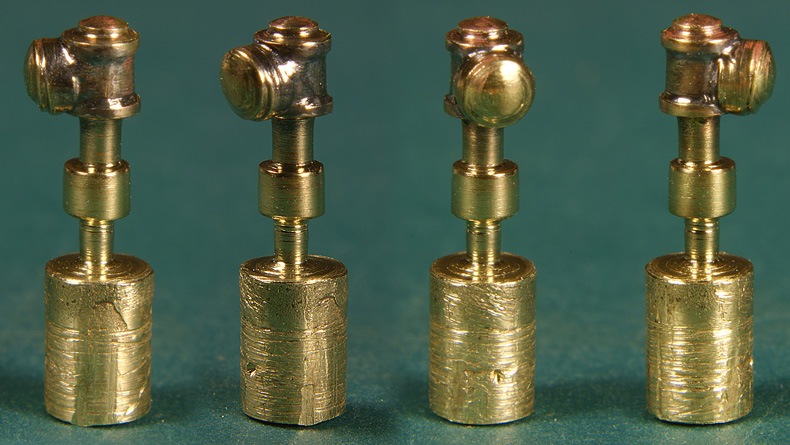Garrattfan's Modelrailroading Pages

SHM 26
Evaluation
In brief
Pro
The fit of the etch work above the footplate was generally satisfying.
The set is pretty complete with most of the last wax brass parts present.
Con
No instruction manual worth mentioning
Below the footplate there were several issues with the fit of the etched parts.
Detailing of the etchwork is not true to prototype and needs extensive rework to correct
The drive supplied with the kit, a Tenshodo SPUD, is only good for the dustbin
General conclusion
Not easy to build if you want an accurate and good running depiction of the loco. Not for beginners.
In detail
I know that €175 is not an awful lot for a kit. However, buying a Philotrain kit includes high hopes on the level of detail and prototype accuracy. I expected the kit, simply for the name alone, to be top notch. I was wrong. Above the footplate most of the etchwork went together reasonably at best. Some parts were pre-bent which makes thing a lot easier.
That is about the good about this kit. There were simply too many points of criticism, much more than I expected for a Philotrain kit
The building manual |
|
 |
I can be brief about that: absolutely insufficient. Apart from an exploded view there was nothing of the sort of a building instruction in plain text. No background information on the prototype was provided nor any hints how to build the various versions The exploded view contained no information where to put the various fittings so the builder was left in the dark about where all the brass casting had to go. I had to rely entirely on photos. Luckily I had enough of those. I hope the description on this website compensates for that. |
The etch work |
|
| The etch work was generally of good and accurate quality with modest cusps and clear straight lines. But there were many details in which the model deviated from the protype. There were also some errors in the design. | |
 |
All sides of the area below the footplate were provided in one etch. You'd expect a perfect fit. Wrong, the buffer beams were more than 1 mm too wide.
|
 |
The sides of the watertanks were curved slowly inward where the prototype always had straight tanks which angled inwards 90 degrees with a visible radius. Moreover the water tanks etches had embossed lines that were never present on the prototype
The sides of the watertanks had two steps etched in the front end and even three at the back end, where the prototype never had more than one at each end. The step(s) where also in the wrong place. |
 |
A lot of work really, basically only to retain the fine etched manhole hatch in the middle of the tank. In hindsight I had better cut and bent a whole new tank side from brass sheet, cut out the the hatch and solder it on the new tank side. A lesson learned.
|
 |
The front and back skirts behind the buffer beams did not match the form of the water tank etches, neither as provided neither as per prototype. Moreover the front and rear skirts were not true to prototype. |
 |
This time I had the idea to make new instead of plodding on with the old ones. |
 |
The driver's cab had window frames and embossed lines that were way too high. Moreover they were round, making it hard to decal. I realised that only after painting so I did not change it. It had been better to sand them down to about half the height. |
 |
The driver's cab had no sliding door in the rear. This may have been a later addition to the loco. |
Boiler |
|
 |
|
 |
The fake watertank is prototypical by the way. |
 |
|
Brass parts |
|
 |
A support for the air pump was not provided. I had to cut it from brass sheet. |
 |
The grease pump on the right side was not provided. This may have been a version issue. Maybe the loco did not have a grease pump before 1982. I turned it from brass. |
 |
I found no bell in the box. This may again have been a version issue. I turned one from brass. |
 |
The same applies to the snifter valve |
 |
The wahsout plugs were too thick and needed turning down |
The drive |
|
 |
Well, this issue beats all others. In short: the supplied Tenshodo is no good. It has two modes: it does not move at all or it breaks the sound barrier. Throw it away and build your own one. I was so fed up with all the work that went into the supestructure to get a reasonable depiction of the original that I used the original drive and put it in my display cabinet as a non-mover. My first one. I built an MDC Roundhouse Shay and made it run well. I built a Backwoods Miniatures NGG16 and made it run well. But I could not beat this bugger of a SPUD. A disgrace to the name of Philotrain. To ease on my comments: I must remember that this kit was produced in 1982, the early years of Philotrain, where many comprmises were made to keep prices low. And to look on the positive side: it offers me an opportunity to build my own drive ;-) Note: in 2019 I bought and built a Universal Power Bogie from Locos n Stuff (Mark Clark) and it works fine. |
 |
The connection of the crank pins to the wheels was not described, but the way suggested by the parts in the kit was flimsy. I devised my own solution While building the Universal Power Bogie I also replaced the wheels with Alan Gibson's. |
Conclusion
If you're are a beginner in building kit: don't buy it. A DJH NS5500 is a better option to start with. Only buy this tram loco if you see no other way of getting a model of this cute locomotive and accept that you are in for a lot of work or alternatively a lot of compromises.


Sign my
GuestBook